Last updated: July 17th, 2023
Rain poses a dilemma if you like to commute in everyday clothing.
On the one hand, you don’t want to show up at your destination looking like a mountaineer or a Lycra-clad “serious cyclist.”
Still, you’ve got to stay dry…or at least dry-ish.
This article will share a handful of clever designs that manage to function well on a rainy bike commute and look decent when you hop off the bike.
For yourself or as a style-conscious gift, these are some of the best options on the market today.
By the way, they’re good for much more than cycling! Most of the criteria and suggestions below apply to any sort moderate activity, including brisk walks around town.
This article might contain affiliate links. As a member of programs including Amazon Associates, I earn from qualifying purchases.
What to look for in urban cycling rain jackets
First, do you actually need one?
A rain jacket doesn’t always make sense. This rainwear guide explains in more detail, but in brief:
- Cycling ponchos are terrific when the wind is mild and off-bike style isn’t a concern (such as commuting to a workplace you’ll stay inside all day). They’re as ventilated as it gets, and some good ones are quite cheap.
- A water-resistant windbreaker may suffice for quick trips in a sprinkle. It’s often easier and more comfortable to get just slightly damp and dry quickly, compared to carrying heavier, stuffier rainwear.
Still, there are many situations when a true rain jacket is simply the best choice.
And that’s what we’ll cover below.
Simple, enduring style
Nice rainwear is expensive. The best way to stretch your money is to choose a style that’ll look good five or ten years ago and will still look good in five or ten more. We’re aiming for the Lindy effect, in other words, not for eccentric Zara designs.
In practice, this means:
- Restrained colors and patterns. Solid neutrals are always a good choice, and deep reds may be more visible without looking “high-viz.” You can always throw on a high-viz running vest (like this or this) if the situation calls for it.
- No decorative “fashion-forward” touches like epaulets or superfluous zippers.
- A moderate, tailored cut. Fashion vacillates between skinny and baggy, so avoid going too far in either direction.
Waterproof fabric
Waterproofing goes without saying, but there’s more than one way to achieve it.
Waterproof-breathable synthetic fabric
For technical synthetic jackets, look for either a 2.5- or 3-layer fabric waterproof-breathable fabric. The manufacturer will clearly state this in the description and/or on the tag. (While 2-layer fabrics are cheaper, they’re not particularly durable, so it’s worth spending a little more.) A 3-layer textile is the most durable and breathable of the lot, and feels best against your skin due to its inner layer. It’s also the most expensive.
Virtually all technical waterproof fabrics are lightweight and sometimes stretchy, but they require special care to maintain the durable water-resistant (DWR) coating. Ultra-light ones are often delicate and easily torn.
Rubberized fabric
You can also find a traditional rubber- or urethane-coated fabric. They’re the epitome of a classic look, if that’s your thing, and require essentially no special care. The fabric itself isn’t breathable, but the design usually has enough ventilation (more on that below) for low-key cycling. They’re just not ideal for high-effort riding.
Waxed/oiled canvas
Finally, waxed or coiled canvas is another traditional fabric that has made a comeback in recent years. Good ones are expensive and exceedingly heavy, but fairly breathable and extremely durable. They’ll never be perfectly waterproof, however, so save them for milder rain.
Whether you prefer a traditional or technical jacket, look for sealed/taped seams. Cheap jackets often omit these, but they’re essential. Otherwise, water may seep through holes from stitching, which renders waterproof fabric almost useless.
If storage is a concern, then synthetics are the way to go. They back down tightly—sometimes into their own pocket—making them easy to stow when the weather clears up.
A hood…or not?
Not everyone needs a hood on their cycling rain jacket. Your head release a great deal of heat even during modest exertion. Leaving it uncovered is a terrific way to stay cool. Your hair will undoubtedly get wet, but perhaps rain is preferable to sweat.
They’re potentially useful off the bike, but unnecessary (and often annoying) on it. Whether you need one depends on how frequently you’ll wear it for cycling versus all other uses.
Among the cycling jackets that do have hoods, they’re often large enough to fit over a helmet. That’s cooler and more comfortable than wearing a conventional hood under a helmet. However, the extra volume to accommodate a helmet may look strange when you’re off the bike.
And if you do prefer a hood, make sure it has these two things:
- A structured brim that extends out over your face and
- Solid adjusters that let you cinch it down to avoid catch rain or wind
Great ventilation
The goal is to seal rain out without sealing body heat and sweat in. Ventilation is key—and that’s what most casual rainwear lacks.
By the way, I deliberately said “ventilation” (i.e., airflow) rather than “breathability.” Waterproof-breathable fabrics are quite a feat of engineering, but they’re nowhere near as breathable as you’d hope. They do help, but circulating fresh air is more comfortable and more effective.
To that end, you’ll need thoughtfully placed vents in the fabric. They’re vents are practically free to make, yet extremely effective.
Look for underarm and upper-back vents, in particular, since that’s where you generate the most heat when active.
It’s even better if there are two zipper pulls, since you can unzip slightly from the bottom to get more circulation without much more rain exposure. Snaps are another great way to accomplish the same thing—just make sure there’s also a zipper, otherwise the gaps between snaps will admit water.
A cut with room to move
Your riding posture determines what jackets are comfortable.
Almost any jacket is comfortable on a Dutch-style bike. After all, you’re sitting upright with your arms are barely extended. There’s no need for stretchy material or a special cut that your daily life doesn’t already require. (Although reflectivity is always nice.)
But you need a little more freedom of movement for a typical, North American hybrid-style commuter bike. “Normal” jackets might still suffice, but it doesn’t hurt to have lengthened sleeves, back-of-shoulder gussets, and even a little stretch. There are countless options at any outdoors retailer, but finding genuinely stylish ones is harder—hence this article!
If you ride standard road bike or anything else with significantly forward-leaning posture, then you’ll be more comfortable in cycling-specific clothing. The catch is that whatever that works on a road racing bike looks downright strange when you’re walking around. The shortened front, extended back, and elongated arms scream “athletic” apparel. That’s the antithesis of practical, everyday cycling, so we won’t cover these sorts of jackets here.
High-visibility details (nice, but optional)
It’s also nice to have subtle high-visibility features. One common approach is reflective material hidden inside gussets. Done right, they’re discreet when walking but conspicuous when riding.
You may also find reflective threads woven into the jacket, often in a tasteful check pattern. They typically appear black or dark gray in daylight. Unlike reflective gussets, this approach makes you reflective from all directions.
As mentioned earlier, don’t fret about high-visibility details. You can always don a bright or reflective vest, then remove it after riding. (And proper bicycle lighting is also extremely important.)
The best men’s rain jackets for bike commuting in style
Over the last several years, I’ve tested heaps of jackets and spent far too many hours researching dozens more. As of 2022, a few clear winners have emerged.
To be clear, this is compiled with practical, transportation-focused cyclists in mind. There are better options for vigorous sport cycling, extended touring, and the like. But if you value the convenience of cycling in everyday clothing, whatever the weather, then read on!
My favorite for urban cycling: Brompton London
For the right person, Brompton folding bikes are a perfect tool for everyday life. So, when they introduced a new clothing line in partnership with Endura, expectations were high.
The line aims to be “Clothes for cycling, for people that don’t wear cycling clothes.” And that’s the London Waterproof Jacket in a nutshell.
It evokes a Barbour coat—a timeless design if ever there was one—but with modern fabrics and a more accessible price.
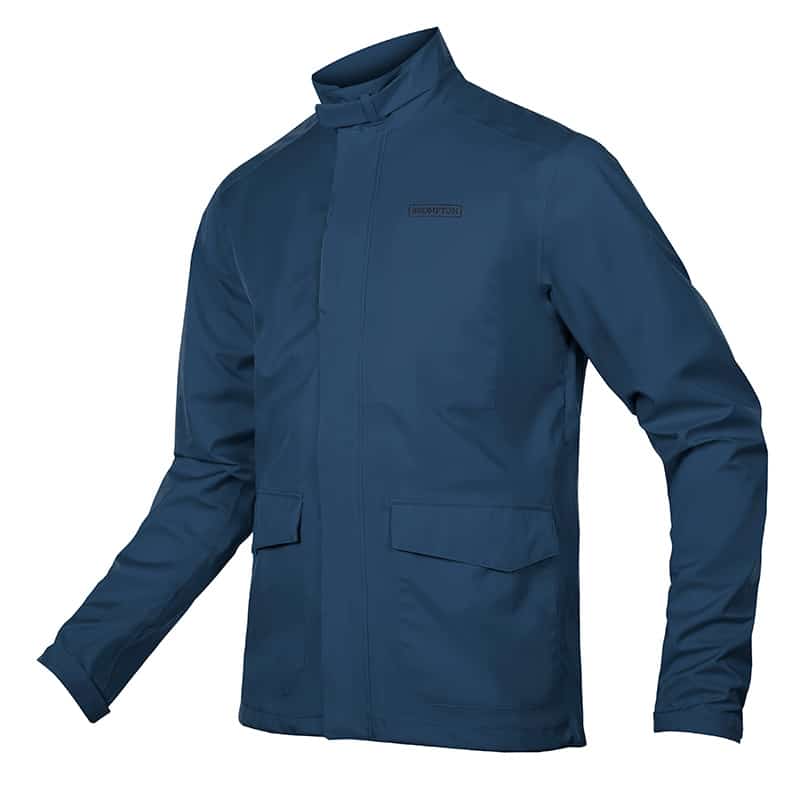
The London jacket is completely watertight thanks to a breathable 3-layer fabric with fully taped seams. The fabric is breathable, of course, but the most important ventilation feature is the underarm zipper vents. The combination of a front zipper and snaps gives you more ventilation options, too. The zipper itself is not waterproof, but it’s tucked away under a storm flap.
For visibility, Brompton added reflective elements on the the cuffs, hem, upper back, and chest. They’re well placed for visibility in riding position, and most are concealable during the day.
It does not have a hood—which I don’t mind in the slightest—but you can raise and cinch down the collar to seal out squalls.
At roughly $200, it’s not remotely cheap, but the price is actually less that 3-layer technical jackets from most major outdoors brands.
Unfortunately, past Brompton collaborations have only lasted a season or two, so it may be hard to track down by this time next year.
Check price and availability here for the navy and red versions.
The versatile, budget winner: Uniqlo Blocktech Parka
At this point, Uniqlo practically owns the cheap-but-good technical apparel market. That’s largely thanks to their Blocktech Parka.
The design is thoroughly stripped-down. Minimalist, one could say.
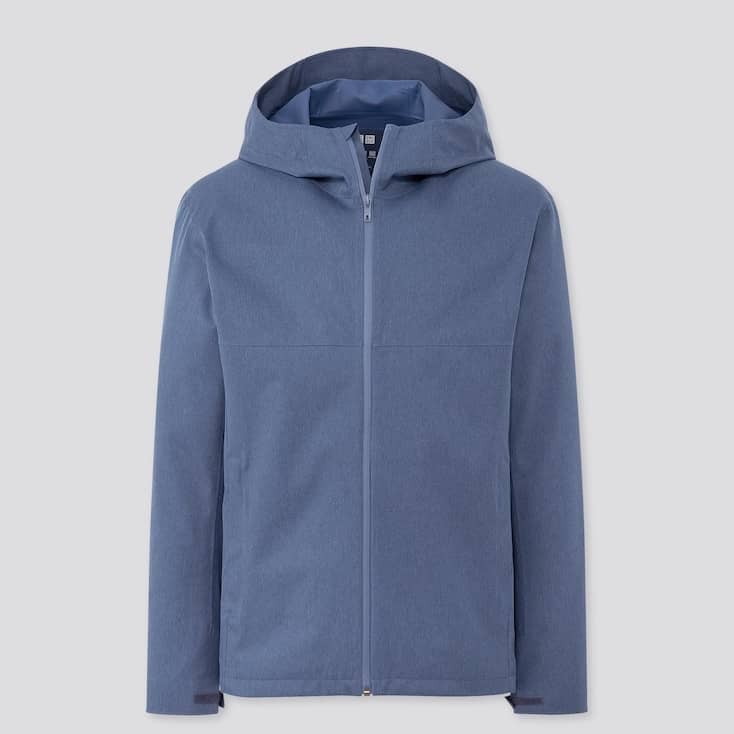
The 2.5-layer waterproof-breathable fabric has significant stretch, so you can keep a trim silhouette without bursting at the (fully taped) seams. It also includes a hood with a nicely structured brim, although the hood adjusters can be a little finicky and prone to slipping when very tight.
Ventilation is its weak point, with a one-way zipper, no snaps, and no vents on the men’s version. When the jacket is zipped, you have to rely on the fabric’s limited breathability alone. (Although, perplexing, Uniqlo does put underarm vents in the women’s version.)
Still, it’s available worldwide at a more than reasonable price. For urban cyclists on a budget, and who won’t ride hard enough to miss the ventilation, it remains hard to beat.
(Uniqlo changes small things from season to season, like colors, fastener hardware, and even the shape of the hood’s brim. If you try and like the current version, then I suggest buying it just in case those details change for the worse.)
Check price and availability here.
A tough, tactical cycling rain jacket: Chrome Storm Salute
Chrome is one of the longest-standing urban cycling brands, best known for messenger bags that have adorned messengers (and messenger-inspired hipsters) since the late 1990s.
Their apparel is equally practical and rugged. And if that lines up with your style, then their Storm Salute is just about perfect.
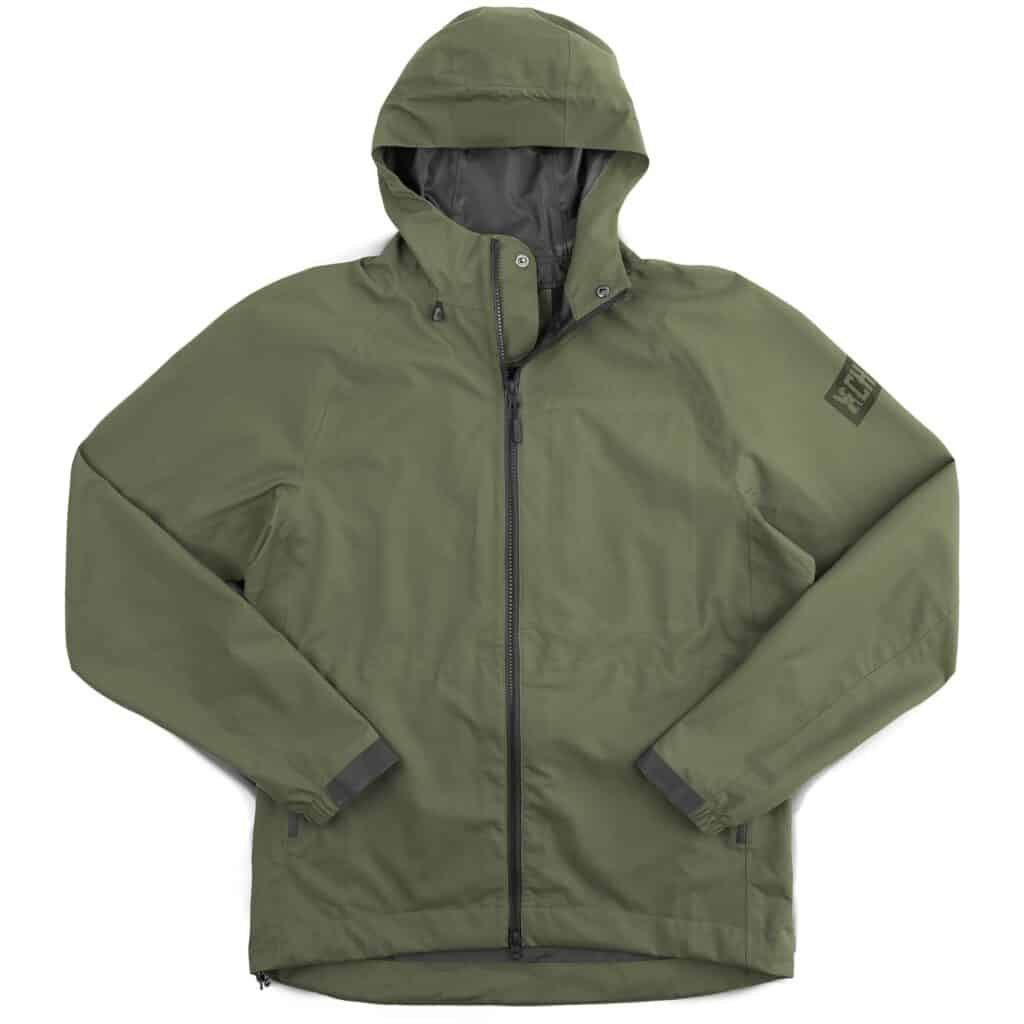
It uses a 2.5-layer waterproof-breathable stretch fabric to keep cost and bulk under control. Seams are fully taped, the hood is adjustable and helmet-sized, and there’s large yet discreet reflective tape on the cuffs and back.
Ventilation is handled with a two-way zipper and sizable back vent. That’s sufficient for most commuters, but I’d like to have seen underarm vents to keep it extra-breezy. Those would be especially nice for the harder-charging urban fixie and messenger scene that Chrome generally caters to.
One unusual feature is the enormous lower-back pocket, perhaps inspired by the pockets on cycling jerseys. It has plenty of space for your everyday carry, and (with practice) is accessible while riding.
If you like the a more minimalist aesthetic or classic menswear looks, then Chrome is evidently not the brand for you. But if you lean more tactical, then they’re the standard.
The price is consistent with other 2.5-layer jackets. Although Chrome does revise their jackets on occasion, I’d expect it to be available for at least a couple seasons.
Check price and availability here.
The old-school classic: Rains Jacket
Nothing is simple nor more reliable waterproof than good old rubberized fabric. And it’s impossible to look out of place in a classic cut like the Rains Jacket (an apt name if ever I’ve seen one).
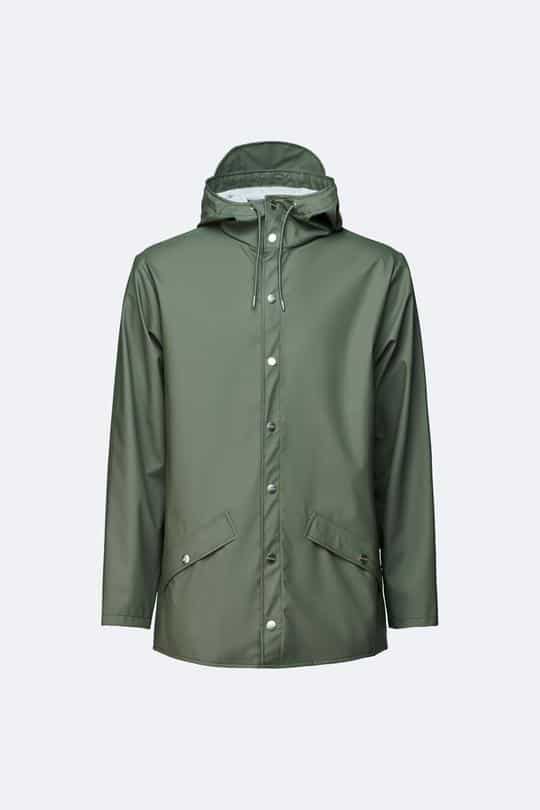
You don’t often (or ever?) see it in lists like this for two reasons. For one thing, it’s hardly novel. For another, the fabric itself precisely 0% percent breathable, which is the flip side of 100% waterproof fabric.
However, for those of us who treat cycling as moderately active transport—similar to a brisk walk—it’s surprisingly easy to live with. Even easier, in fact, because the fabric requires no special detergents, DWR treatments, or other fussiness like a technical jacket does.
Ventilation is excellent for non-athletic use. There are no underarm vents, but the front snaps, upper-back flap, and underarm perforations are effective together. It’s assuredly not for vigorous exercise, but the vents and the airy cut keep you cool for laid-back cycling.
However, snaps are the only fasteners in the front. There’s no zipper. Having owned one, I can attest that the snaps work in heavy rain, but they may not totally block utter downpours or strong winds.
Along those lines, seams are unfortunately not taped or welded. To my pleasant surprise, I never actually experienced leaks. But that’s not out of the question, either.
The hood is fairly comfortable on its own, with a nicely structured brim that most traditional raincoats are missing. Hood adjustment is a bit limited, since the cinch is inelastic and does not have fasteners. (You could easily add your own toggles like these, however.)
You might notice the similarity to Stutterheim at a glance. And while the Rains coat lacks Stutterheim’s high-end materials or meticulous attention to details, they’re quite functionally similar at about one-third the cost.
There’s also a long version for more rain protection while walking. You’ll want a coat guard, however, to prevent its added length from catching in the rear wheel. Dutch bikes often include one, but most of us would to to add an aftermarket ones like this.
Check price and availability here.
Stylish with natural fabric (when money’s no issue): Hilltrek Greenspot DV Heritage
Whether you like natural fibers for durability or just as a matter of principle, they do hold a certain appeal. But it usually entails heavy, bulky fabric with disappointing water-resistance despite a high price.
Hilltrek may be the best exception to this rule. The price is a bit painful, but it gets you perhaps the only totally waterproof cotton rainwear on the market. And, with the Greenspot DV Heritage jacket, it’s in a stylish and slightly retro form that doesn’t remotely scream “cyclist here!”
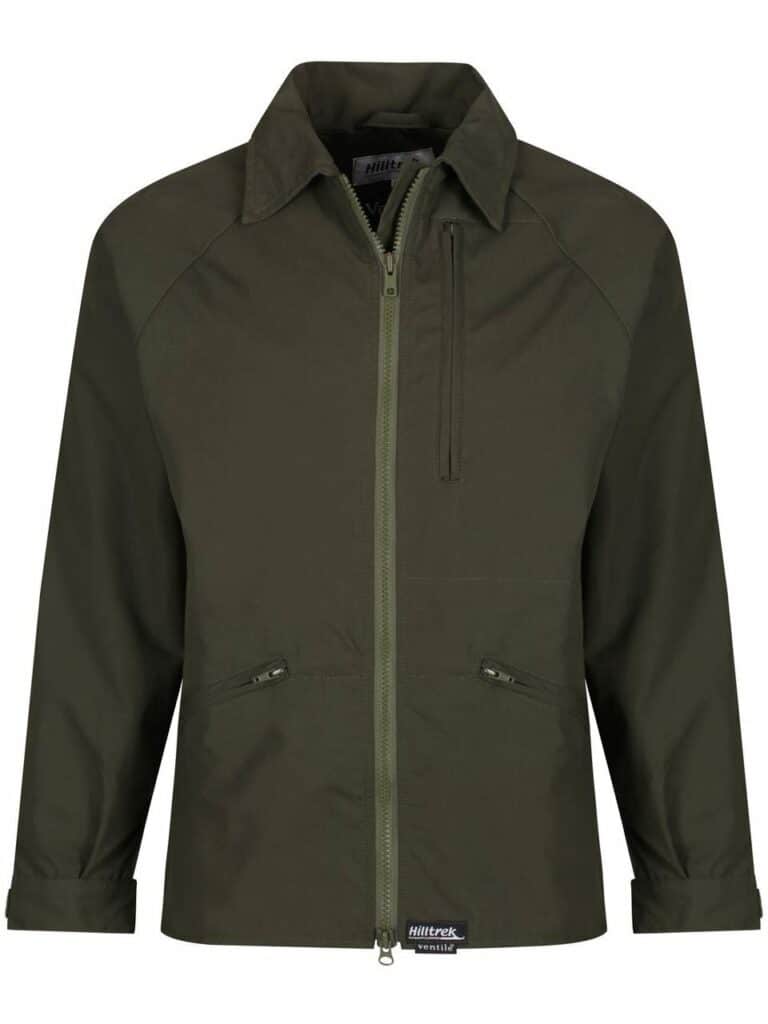
Much like the Brompton London jacket covered earlier, it’s as useful to someone without a bike as to someone who practically lives on one. And it’s that restrained and versatile style that makes it easier to justify such a purchase.
The cut is tailored, not slim, although the waist cinches make it easy to customize the fit. Sleeve length and waist length should work for upright to moderately forward-leaning bikes. Notably, Hilltrek is one of the only companies that allow for custom body and sleeve lengths. There’s a modest fee for such requests, but it’s well worth it for a customized fit on a potentially lifelong purchase.
Note that there is no hood, and the collar does not tighten in place when you stand it up. Ventilation is limited to the zipper and cuffs. There are no back or underarm vents, but by the few accounts I could find, airflow is fine without them.
Hilltrek products, like all treated cottons, are more durable than most synthetic or rubberized jackets. They’re also easily repaired by Hilltrek, and entirely made in Scotland, for what it’s worth. If anything on this list is a potential heirloom, you’re looking at it.
Check price and available here.
(They do have a large range beyond this model, too. Some jackets lean toward the sportier side whereas others are more classic trekking attire.)
Worth watching: Swrve
Los Angeles-based Swrve makes all sort of cycling-and-beyond apparel—some of it quite ingenious.
They don’t offer a waterproof shell as of writing, although the lightly insulated Milwaukee ES comes close. It’s worth checking their entire jacket line periodically for seasonal updates (as well as other layers that might come in handy).
Even without a specific model to suggest, I mention Swrve because the founders are long-time cyclists themselves. Bike-friendly features like reflectivity and abundant ventilation show up in virtually everything they offer.
They do tend to cut jackets with a long rear hem that looks odd off the bike, but if that doesn’t bother you, then this is a brand to keep an eye on.
Your cycling jacket questions, answered
What should I wear under my jacket?
For relaxed riding, including most bike commuting, simply wear your normal clothes under your rain jacket. Anything you’d wear for a brisk walk is appropriate, although you might want to remove mid-layers to keep from overheating.
Depending on the fabric, you might be more comfortable in long sleeves. 2- and 2.5-layer technical fabrics have a slick inner coating that feels very sticky with even a hint of perspiration. It also feels extremely cold in a stiff wind. That’s rarely an issue with 3-layer synthetics or with traditional rubberized/waxed materials, all of which have actual fabric against your skin.
Cotton is a poor base layer because it holds moisture. That’s chilly when cold and sticky when hot. If you do ride hard enough to work up a sweat, then choose a shirt in merino wool or a high-quality, odor-resistant synthetic.
But the easiest way to avoid fussing with base layers is simple to avoid sweating heavily. Not only is a modest pace pleasant, but it makes it easier to cycle in regular clothing.
How should I care for my rain jacket?
If the manufacturer gives specific instructions, then follow them precisely. It’s best to wash your rainwear as infrequently as possible—perhaps just once or twice per year. If it gets dirty, spot-clean it instead. You may also need to restore the DWR coating after or between washes. If the manufacturer recommends specific brands of care product, then use them alone.
Note that technical (synthetic) fabrics, traditional rubberized fabrics, and waxed cotton all require completely different care and maintenance. Again, you’ll get the best performance and longevity by heeding the designer’s guidance.
Why am I still wet inside my waterproof jacket?
Waterproof fabrics can be defective, but the likelier reason is a faulty zipper or overly loose cuff or collar. Water can easily enter these, especially if it’s windy. However, your own body’s moisture will condense on the jacket’s lining, and it’s easy to mistake that for water from outside.
DWR coatings also degrade over time, especially with friction (e.g., backpack straps) and washing. As the coating breaks down, water won’t bead up and roll off as easily. Instead, it starts to soak the outermost layer of fabric. This is known as “wetting out,” and it’s a sure sign that you need to replenish the DWR per the manufacturer’s instructions.
To be clear, wetting out does not mean soaking through. the waterproof membrane/lining prevents that. But wet fabric can’t breath as designed, so even more condensation builds up.
